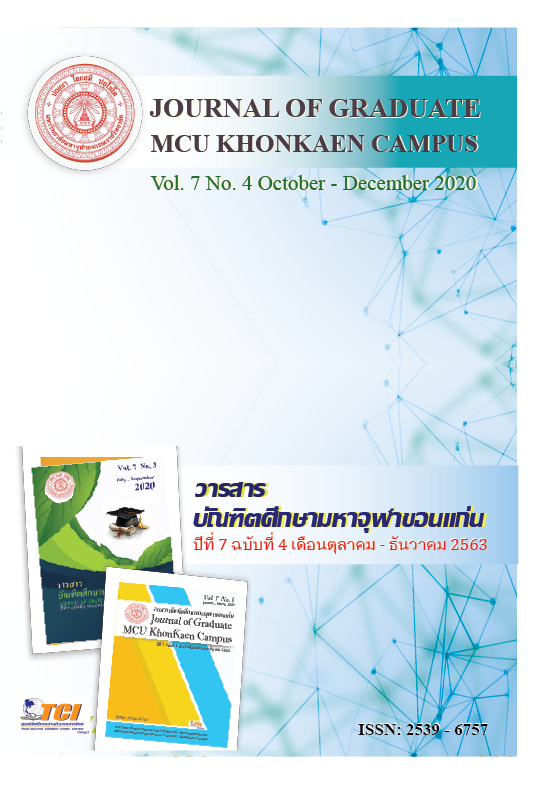THE VALUES AND IMPORTANCES OF BUDDHIST BOUNDARY STONE (BAI SEMA), FA DAET SONG YANG DISTRICT, KALASIN PROVINCE
Main Article Content
Abstract
The Buddhist boundary stone (Bai Sema) at Fha Daed Songyang district, Kalasin province, was established to serve Buddhism by showing the art in order to convince Buddhist lay people sacrifice in Buddhism more profoundly. It could be more recognized by the doctrine of the Buddha in order to be a representative, the describable feeling, thoughts, beliefs to express concrete. It was a tool to convey the beliefs, aspects on Buddhism in order to make it touchable concrete by eye-opening. This led the knowledge, understanding regarding the story of Buddhism as well as the impression leading to the faithfulness as a representative of Buddha to be respected by Buddhists. The Buddhist boundary stone (Bai Sema) was established as the object in order to be a representative or symbol, the describable feeling, ideals, and beliefs as abstract replaced as concrete. This aims to a centre of beliefs in Buddhism. Buddhist lay people worship it. Building the Buddhist boundary stone (Bai Sema) must be built by a persistent and valuable object. There is a great creation process that make it a spiritual object. This value can be recognized from the relationship of the appearance linking between Buddhist concepts and local wisdom.
Article Details

This work is licensed under a Creative Commons Attribution-NonCommercial-NoDerivatives 4.0 International License.
References
กรมศิลปากรหน่วยศิลปากรที่ 7. (2500). รายงานการสำรวจและขุดแต่งโบราณสถานเมืองฟ้าแดดสูงยาง บ้านเสมา ตำบลหนองแปน อำเภอกมลาไสย จังหวัดกาฬสินธุ์ พ.ศ. 2500 – 2511.
เบญจมาศ พลอินทร์. (2524). วรรณคดีขนบประเพณีและศาสนา. กรุงเทพมหานคร : ภาพพิมพ์.
ประสาท อิศรปรีดา และคณะ. (2518). ความเชื่อและสิ่งยึดเหนี่ยวทางจิตใจของชาวอีสาน. มหาสารคาม : มหาวิทยาลัยศรีนครินทรวิโรฒมหาสารคาม.
ประอร ศิลาพันธ์. (2536). ภาชนะดินเผาในแหล่งโบราณคดีลุ่มแม่น้ำชี : กรณีศึกษาภาชนะดินเผาที่ได้จากการขุดค้นเมืองฟ้าแดดสงยาง อำเภอกมลาไสย จังหวัดกาฬสินธุ์. วิทยานิพนธุ์มหาบัณฑิต สาขาวิชาโบราณคดีสมัยประวัติศาสตร์. บัณฑิตวิทยาลัย : มหาวิทยาลัยศิลปากร.
ปรีชาวุฒิ อภิระติง. (2560). พุทธศาสนากับระบบกษัตริย์ในวัฒนธรรมทวารวดีอีสาน : วิเคราะห์จากงานศิลปกรรม. วารสารศิลปกรรมศาสตร์ มหาวิทยาลัยขอนแก่น, 9(1), 365-386.
ผาสุก อินทราวุธ. (2537). วัฒนธรรมทวารวดีในภาคอีสาน วิเคราะห์หลักฐานจากแหล่งโบราณคดีเมืองฟ้าแดดสงยาง.
พระพรหมคุณาภรณ์ (ป.อ. ปยุตฺโต). (2558). พจนานุกรมพุทธศาสตร์ ฉบับประมวลศัพท์. (พิมพ์ครั้งที่ 24). กรุงเทพมหานคร : ผลิธัมม์.
พระราชวรมุนี (ป.อ.ปยุตฺโต). (2539). ความงามในทัศนะทางพุทธศาสนา. ปาจารยสาร, 14(1)
มหาจุฬาลงกรณราชวิทยาลัย. (2530). พระไตรปิฎกภาษาไทย ฉบับมหาจุฬาลงกรณราชวิทยาลัย. กรุงเทพมหานคร : โรงพิมพ์มหาจุฬาลงกรณราชวิทยาลัย.
มุณี พันทวี. (2530). ครูศิลปะ. มหาสารคาม : เฟื่องอักษรการพิมพ์.
สุชานาถ สิงหาปัด. (2560). ร้อยภาพเล่าเรื่องเมืองกาฬสินธุ์. มหาวิทยาลัยกาฬสินธุ์ : ศิริภัณฑ์.

